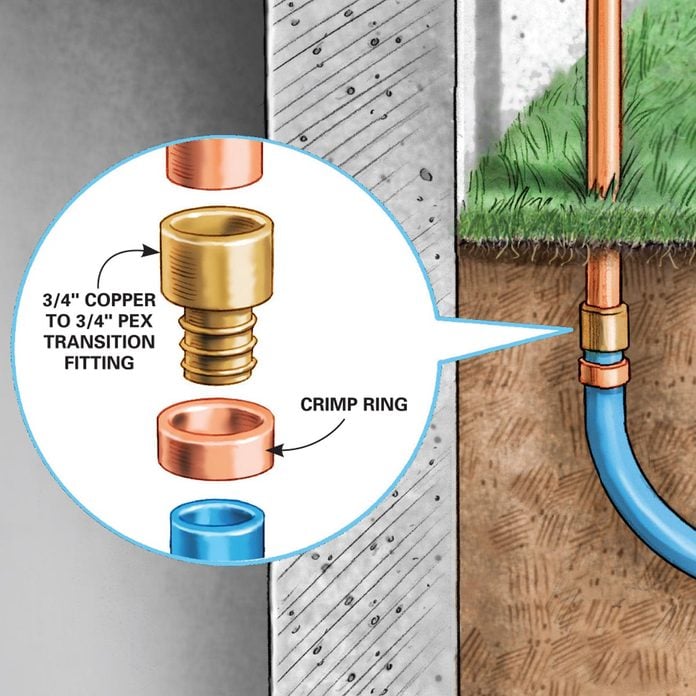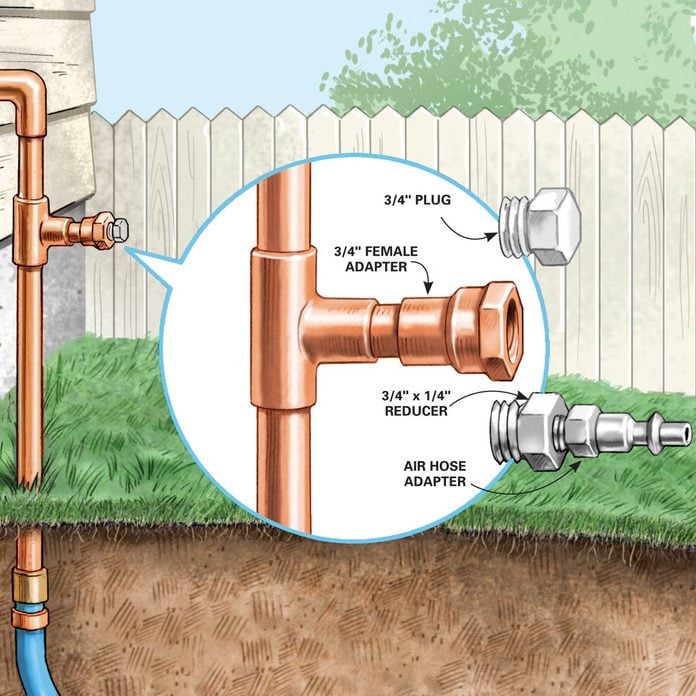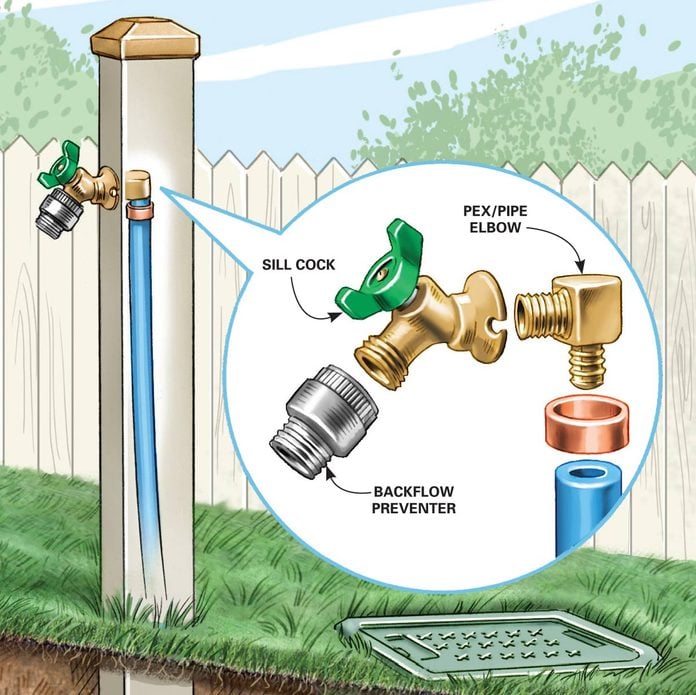How to Blow Air Through a 34 Inch Pipe Easy
How to Install an Outdoor Faucet
Stop lugging around that hose
![]() Time
Time
Multiple Days
![]() Complexity
Complexity
Beginner
![]() Cost
Cost
$51–100
Introduction
Make watering your lawn or garden easier with a remote outside faucet. Instead of dragging long lengths of hose, run a permanent underground pipe with a blowout valve to a convenient spot.
Tools Required
Materials Required
- 3/4-in. copper pipe and fittings
- 3/4-in. copper T
- 3/4-in. female adapter
- 3/4-in. PEX T
- 3/4-in. PEX to copper transitions
- 3/4-in. plug
- 3/4-in. x 1/4-in. reducer
- backflow preventer
- Flux
- Gravel
- Lead-free solder
- PEX/pipe elbow
- PVC fence post
- Sandpaper
- Shutoff valves
- Sill cock
- Sprinkler system valve box
Installing The Pipe and Faucet
If dragging hoses around is a constant activity in your yard, install a remote faucet and eliminate that hassle forever. The job will take you a day or two (depending on how much trenching is required) and cost less than $100. Everything you'll need is available at home centers.
Digging the trench:
Call 811 a few days before you dig so the utility companies can locate buried pipes and cables in your yard. You only have to bury the water line about 6 in. deep. If you're trenching in hard clay or rocky soil, that's about as deep as you'll want to go. If you're working in soft soil, it's smart to go at least 12 in. deep to reduce the risk of future damage. At any depth, you can easily protect the water line from shovel attacks: Cover the tubing with a couple of inches of soil, then pour in about 2 in. of the dry concrete mix before backfilling the trench. Soil moisture will harden the concrete.
Once you're done with this project, check out how to make your backyard the ultimate outdoor space.
Project step-by-step (4)
Step 1
Plumbing the Faucet

PEX Tubing
PEX tubing, which is flexible and more resistant to damage from freezing, is the best choice for the supply line to the faucet.
The inside connection
To get the best flow rate at the garden, tap into an interior 3/4-in. cold water line. If you can't find one that's convenient, tap into a 1/2-in. line instead (you'll just get a slightly lower flow rate). If you have a water softener, tap into a water line before the softener.
Step 2
Copper to PEX Transition

The pipeline
Copper pipe is best for the exposed plumbing at the house, but PEX tubing is best for the underground. It's a lot cheaper than copper and it's easier to install than CPVC plastic. With PEX, you can make a continuous run from your house and can make turns without installing a single fitting. Plus, PEX tolerates mild freezing better than either CPVC or copper (in case you're late blowing out the line). However, you'll have to invest in a 3/4-in. PEX crimping tool. If you don't want to shell out the cash, use CPVC.
Attaching PEX to a copper line
To attach PEX to a copper line, solder on a transition fitting, then crimp the PEX to the fitting with a crimping tool.
Step 3
Blow-Out System

The blow-out system
If you live in a freeze zone, you'll have to blow out the system before the first hard freeze. It's easy to do with a home air compressor, but you'll have to install the components now (instead of during a snowstorm).
At the house, splice in a tee and a threaded female 3/4-in. adapter, and cap it with a plug. That's where you'll connect your compressed airline.
At the garden, install a blow-out valve (a ball valve is best) below grade in a gravel pit. Use a sprinkler system valve box to cover it. Before the first freeze, close the shutoff valve and unscrew the plug. Next, screw in a standard air hose fitting and a reducer and connect your air hose. Out at the faucet, open both the faucet and the blow-out valve and let the water drain. Then, close just the faucet and blow out any remaining water with your compressor. Finally, close the blow-out valve and replug the blow-out fitting back at the house.
Step 4
Mounting the Faucet

The post and faucet
We cut a length of hollow PVC fence post to mount the faucet, but you can build your own post out of any material. Make sure the PEX runs inside it to protect it from sunlight—UV rays reduce its life. Set the post at least 18 in. deep. Screw the sill cock flange to the post and install a screw-on backflow preventer.
Note: Check with your local plumbing inspector for backflow prevention requirements in your area.
These outdoor projects will boost your backyard fun this season. Check out how to build one of these 8 outdoor projects yourself.
Originally Published: November 18, 2019
Source: https://www.familyhandyman.com/project/how-to-install-an-outdoor-faucet/
0 Response to "How to Blow Air Through a 34 Inch Pipe Easy"
Post a Comment